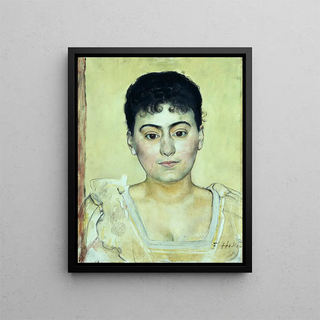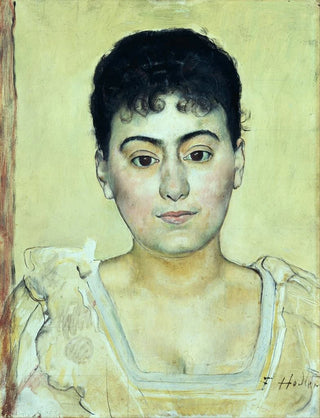Art print | Portrait of Madame de R - Ferdinand Hodler


View from behind

Frame (optional)
Discover the captivating introduction to the Art print Portrait of Madame de R by Ferdinand Hodler. This iconic piece transcends mere representation, showcasing the artist's undeniable talent and the introspective spirit of an era marked by symbolism. Through this portrait, Hodler captures the very essence of his model, revealing a psychological depth that invites viewers to ponder the personality of the depicted woman. More than just an image, this artwork embodies a dialogue between artist and subject—a subtle exchange expressed through palpable emotional intensity.
Style and uniqueness of the work
Ferdinand Hodler's style is distinguished by bold use of colors and shapes. In the Art print Portrait of Madame de R, the artist employs a rich palette, oscillating between warm tones and darker shades, creating a play of shadows and light that enhances the three-dimensionality of the face. The composition is carefully arranged, with each element designed to strengthen the visual impact of the piece. The model's posture, both elegant and natural, suggests a certain nobility, while her direct, penetrating gaze seems to challenge the viewer, inviting them into her universe. This ability to fuse pictorial technique with emotional storytelling is what makes this work so singular and timeless.
The artist and his influence
Ferdinand Hodler is a key figure in Swiss and European art, whose influence extends far beyond his era. Trained in classical painting, he evolved towards a style that combines symbolism with elements of Impressionism. His unique approach to light and color, along with his penchant for introspective and psychological themes, has influenced many artists who followed in his footsteps. The Art print Portrait of Madame de R perfectly exemplifies this quest for depth and truth, establishing Hodler as a pioneer in exploring human emotions through art. His legacy endures, and his work continues to inspire generations of artists, who see in him a model of sensitivity and

Matte finish

View from behind

Frame (optional)
Discover the captivating introduction to the Art print Portrait of Madame de R by Ferdinand Hodler. This iconic piece transcends mere representation, showcasing the artist's undeniable talent and the introspective spirit of an era marked by symbolism. Through this portrait, Hodler captures the very essence of his model, revealing a psychological depth that invites viewers to ponder the personality of the depicted woman. More than just an image, this artwork embodies a dialogue between artist and subject—a subtle exchange expressed through palpable emotional intensity.
Style and uniqueness of the work
Ferdinand Hodler's style is distinguished by bold use of colors and shapes. In the Art print Portrait of Madame de R, the artist employs a rich palette, oscillating between warm tones and darker shades, creating a play of shadows and light that enhances the three-dimensionality of the face. The composition is carefully arranged, with each element designed to strengthen the visual impact of the piece. The model's posture, both elegant and natural, suggests a certain nobility, while her direct, penetrating gaze seems to challenge the viewer, inviting them into her universe. This ability to fuse pictorial technique with emotional storytelling is what makes this work so singular and timeless.
The artist and his influence
Ferdinand Hodler is a key figure in Swiss and European art, whose influence extends far beyond his era. Trained in classical painting, he evolved towards a style that combines symbolism with elements of Impressionism. His unique approach to light and color, along with his penchant for introspective and psychological themes, has influenced many artists who followed in his footsteps. The Art print Portrait of Madame de R perfectly exemplifies this quest for depth and truth, establishing Hodler as a pioneer in exploring human emotions through art. His legacy endures, and his work continues to inspire generations of artists, who see in him a model of sensitivity and






